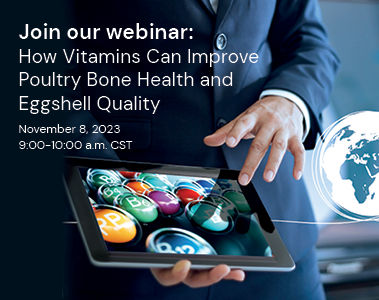
Webinar: How vitamins can improve poultry bone health and eggshell quality
08 Nov 2023
Interested in knowing how vitamins can help improve bone health and egg shell quality in poultry? Join our webinar!
As the global population climbs toward 9.7 billion by 2050, the demand for eggs and poultry products is expected to soar. Meeting this demand requires innovative strategies to enhance productivity while maintaining bird health and welfare. One key factor that often gets overlooked is whether laying hens—or layers—are receiving the optimal levels of vitamins in their feed. Vitamins are essential micronutrients that drive nearly every metabolic process, yet they are often taken for granted in feed formulation.
Why vitamins matter more than ever
While macronutrients like protein, energy, and minerals often dominate conversations about poultry nutrition, vitamins play a vital but understated role. These micronutrients account for only a small portion of feed costs but have a massive impact on bird health and productivity. Without adequate vitamin levels, metabolic functions can be disrupted, leading to reduced egg production, poor shell quality, and greater susceptibility to disease.
Modern laying hens have come a long way from their ancestors. Through genetic advancements, today’s birds can produce up to 500 eggs in a single cycle, compared to around 300 eggs two decades ago. This remarkable productivity comes with increased metabolic demands, requiring precise vitamin supplementation to ensure optimal health and performance.
Environmental factors, such as heat stress or growing incidence of animal diseases, can further complicate the nutritional needs of layers. Birds raised in environments subjected to sudden temperature spikes face oxidative stress, which disrupts cellular processes and compromises their immune systems. Vitamins like C, D and E are critical in mitigating these effects due to their powerful antioxidant properties.
Vitamin C, though synthesized by poultry, is not produced in sufficient quantities during periods of stress. Adding it to the diet helps counteract inflammation, reduce stress hormones, and improve overall resilience. Vitamin D plays a key role not only for proper homeostasis of calcium and phosphorus which is a pre-requisite for best bone calcification and eggshell formation but also, particularly its more active metabolite 25-OH D3 (Hy-D®), to guarantee a more efficient absorption in the intestine and improved modulation of the immune system and less inflammation. Similarly, vitamin E works within cell membranes to combat oxidative damage. Together, these vitamins form a powerful defense mechanism to keep layers healthy and productive even under adverse conditions.
Recognizing the evolving needs of the poultry industry, dsm-firmenich updated its OVN Optimum Vitamin Nutrition® (OVN™) guidelines in 2022. These recommendations are based on decades of research and co-operation with breeding companies and other industry stakeholders and provide a comprehensive framework for vitamin supplementation tailored to modern production systems.
Key updates include:
The guidelines also emphasize the importance of high-quality vitamin formulations. Vitamins are sensitive to heat, oxygen, and light, and poor-quality formulations can degrade before they even reach the birds. Stable, bioavailable forms of vitamins are essential to deliver consistent results and avoid deficiencies.
Providing layers with the right levels of vitamins is not just a matter of optimizing bird health; it also impacts profitability and sustainability. Proper vitamin supplementation improves feed efficiency, enhances egg quality, and reduces food waste.
dsm-firmenich’s 2022 guidelines are a vital resource for poultry producers looking to meet the growing global demand for eggs. By prioritizing vitamin nutrition, producers can protect their flocks, enhance productivity, and promote long-term sustainability in egg production.
19 May 2025

08 Nov 2023
Interested in knowing how vitamins can help improve bone health and egg shell quality in poultry? Join our webinar!

21 Aug 2023
Vitamins have diverse roles in supporting growth, production, and homeostatic functions including immunity. Vitamins roles in supporting immunity range from general (energy metabolism) to specific (gene expression regulated by vitamin D receptors). Our increased understanding of these roles is reflected in dsm-firmenich OVN Optimum Vitamin Nutrition® supplementation guidelines for animal feed. The relative importance of vitamin supplementation increases during special production challenges, such as non-antibiotic programs.

17 Oct 2022
Continuous advancements in poultry nutrition are essential to address opportunities and challenges of modern meat and egg production, including countering the rise of antibiotic resistance, reducing aggressive animal disease and making farming more sustainable in alignment with the United Nations Sustainable Development goals. We at DSM believe that supporting poultry species with optimum vitamins can help make production more sustainable and help get the world closer to zero hunger as well as healthy lives. Optimum Vitamin Nutrition® (OVN) is a cost-effective range of vitamin supplementation optimizing animal health and wellbeing, animal performance and the quality and nutritional value of animal-origin foods.